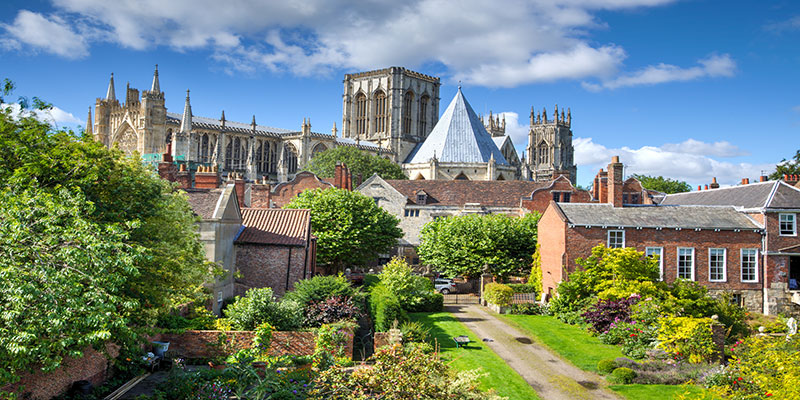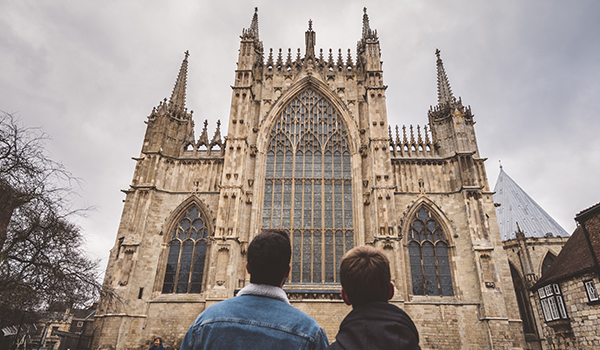
The administrative responsibilities of the Medieval Archbishops of York
The administration of the medieval church in England and Wales existed alongside royal government administration.
To help set in context the principal records of church administration in the north of England - the registers of the medieval Archbishops of York - this page will present an overview of the administrative units of the church, their personnel, and the responsibilities of the Archbishops, the church’s chief officers.
The Archbishops, of whom there are two in England, the Archbishop of Canterbury, and the Archbishop of York, each preside over a province, the highest ecclesiastical administrative unit, with Canterbury taking precedence over York (although in the middle ages this was often disputed). Since they are also bishops of their dioceses, Canterbury and York respectively, they each have many responsibilities as bishop, with added powers as Archbishop or chief bishop of their province.
The medieval Archbishops received authority directly from the Pope, in the form of the pallium, a Y-shaped ecclesiastical vestment worn over the shoulders. The Archbishop’s authority was not confirmed until he had received this from the Pope and professed obedience to him.
Provinces
The medieval Province of Canterbury included the south of England and Wales, comprising 14 dioceses. The Province of York included three dioceses: York, in which the Archbishop acted as bishop; Durham and Carlisle, each with their own bishop, subordinate to the Archbishop of York. The province of York covered all northern England, including parts of Lancashire and the old counties of Westmorland and Cumberland, as well as Nottinghamshire in the Midlands. The Archbishop also had personal jurisdiction over other areas, such as Hexham in Northumberland in the diocese of Durham, and Churchdown in Gloucestershire in the medieval diocese of Worcester, technically described as ‘peculiars’ because of that special jurisdiction.
Places of Worship
Within the provinces, there might be various places of worship, staffed by different bodies or individuals. In the northern province, the three main churches were: York Minster, a secular cathedral, served by clergymen, the dean and chapter under the bishop; and Durham and Carlisle, regular or monastic cathedrals, home to a community of monks and served by the prior and chapter, under the bishop acting as abbot, both with various other officials. Other major churches in the province were the collegiate churches, a college being a body of priests living together. In Yorkshire, these were Beverley and Ripon, and in Nottinghamshire, Southwell, staffed by secular canons, and at Beverley, with a provost in charge of the church lands.
Religious Houses
The northern province was home to many religious houses such as Rievaulx Abbey. These houses often had very large abbey or priory churches in which the monks or nuns worshipped, under the head of the religious house, the abbot or prior, together with other male officers; similar female roles existed in houses of nuns. Unless exempt from the Archbishop's jurisdiction, these houses were subject to him, particularly regarding: his visitations or periodical inspections; elections of heads of the houses; control of who entered the houses, and discipline of errant monks and nuns, such as Joan of Leeds, who shot to fame at the launch of The Northern Way project, also becoming the star of a play in London in 2019.
The Diocese and its Officers
Each diocese was and still is divided into smaller units, archdeaconries, each presided over by an archdeacon under the bishop. In the diocese of York, there are five archdeaconries: York, Cleveland and the East Riding, covering most of Yorkshire; Richmond, covering parts of Yorkshire, also Lancashire, Westmorland and Cumberland; and Nottingham, covering the county of Nottinghamshire. Each archdeaconry is divided into several smaller units, (rural) deaneries, staffed by a (rural) dean, under the archdeacon, and each deanery is made up of a group of parishes. The parish is generally the smallest ecclesiastical administrative unit, presided over by a rector or vicar under the dean, but many also contained chapelries, which cover even smaller areas within them. Other smaller units might comprise chantries in a cathedral or church, in which chaplains would say prayers for the dead, and chapels and oratories in private houses or churches.
Responsibilities of the Bishop
The bishop, as spiritual head of the diocese, had responsibility for the religious life of everyone there, but was solely responsible for confirmation of children, ordination of priests and dedication of churches. If he could not perform such duties, then another bishop, a suffragan, could be commissioned to do so. The bishop would also preside over diocesan synods, meetings of the clergy of the whole diocese at which they would be consulted and instructed, and carry out the Bishop’s Visitation, one of his most important duties, making periodical inspections of all affairs within the diocese, and determining reforms.
The bishop also had judicial responsibilities focussed on the administration within the diocese of Canon Law, a legal system based on the canons, or rules, of the church. This law was administered in several different types of court, of which the bishop’s courts were the highest within the diocese, and the Archbishop’s, the highest in the province; in York, this was the Chancery Court, and in Canterbury, the Court of Arches. These courts dealt mainly with offences concerning morals; for records of causes (cases) in the Northern Province, see the York Cause Papers Project website .
As an administrator, the (arch)bishop was ultimately responsible for the management of the bishopric’s lands, known as the temporalities, as opposed to the spiritualities or spiritual responsibilities of the see. In the province of York, the Archbishop was lord of several manors and lordships and had more than twenty places of residence, such as his palace at Bishopthorpe near York, and Cawood castle. All these would be managed for their income, but would incur expenses of the household, maintenance and payment of officers, such as the steward of the lands of the bishopric, and other officers.
Responsibilities of the Archbishop
There were many areas where the duties of the Archbishops were added to those of their role as bishop; these included taking charge in dioceses where there was no bishop for whatever reason, described as a vacancy of the see. The Archbishop would also oversee all stages in the appointment of bishops, receiving their oath of obedience, and would carry out visitations, as mentioned above. He would also preside over his provincial council, which became known as Convocation, a meeting of all the higher clergy and heads of religious houses in the province to discuss ecclesiastical matters and especially taxation of the clergy. His extra legal responsibilities would be to exercise superior jurisdiction over bishops’ ecclesiastical courts, particularly in appeals, but also to hear cases in his own court. Lastly, he would prove testaments (wills) of those of his province with ‘notable goods’ (goods over a certain value) in more than one diocese of the province.
Besides the officers already mentioned, the bishop or Archbishop was assisted by others, such as the sequestrator, who had responsibilities for taking property into his custody in the name of the bishop if a church were vacant or in dispute, and household clerks, University educated advisors, agents and administrators. In spiritual matters, he might be assisted by chaplains, who staffed his chapel, often performing secretarial duties.
This description of the responsibilities of the bishop and the Archbishop, and and of the types of activities taking place in the areas under their control, give us an overview of the types of business that might have been recorded in the Archbishops’ Registers which are now being examined and made available online through ‘The Northern Way’ project for the 14th century.
Further Reading
- F. Jacob, The Medieval Registers of Canterbury and York: Some Points of Comparison (London, 1953)
- A. Pantin, The English Church in the Fourteenth Century (Cambridge, 1955)
Find out more about the medieval Archbishops of York
